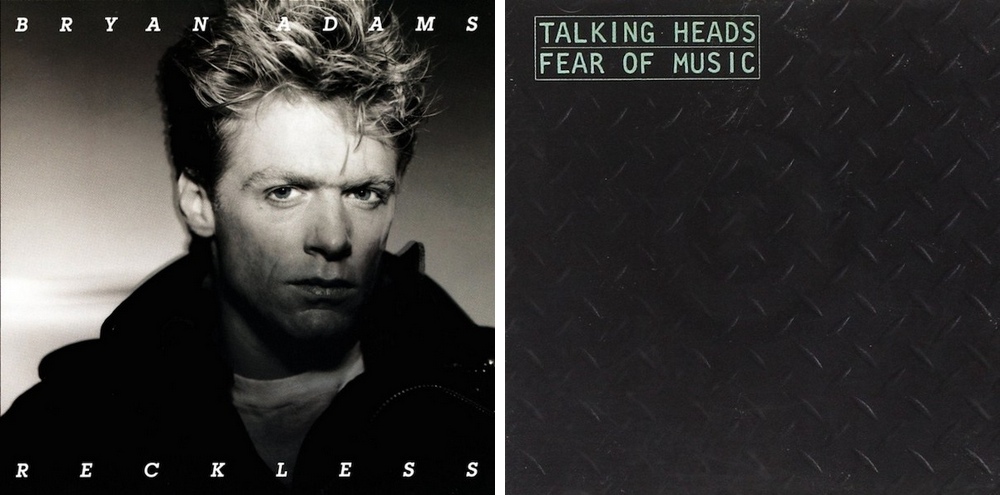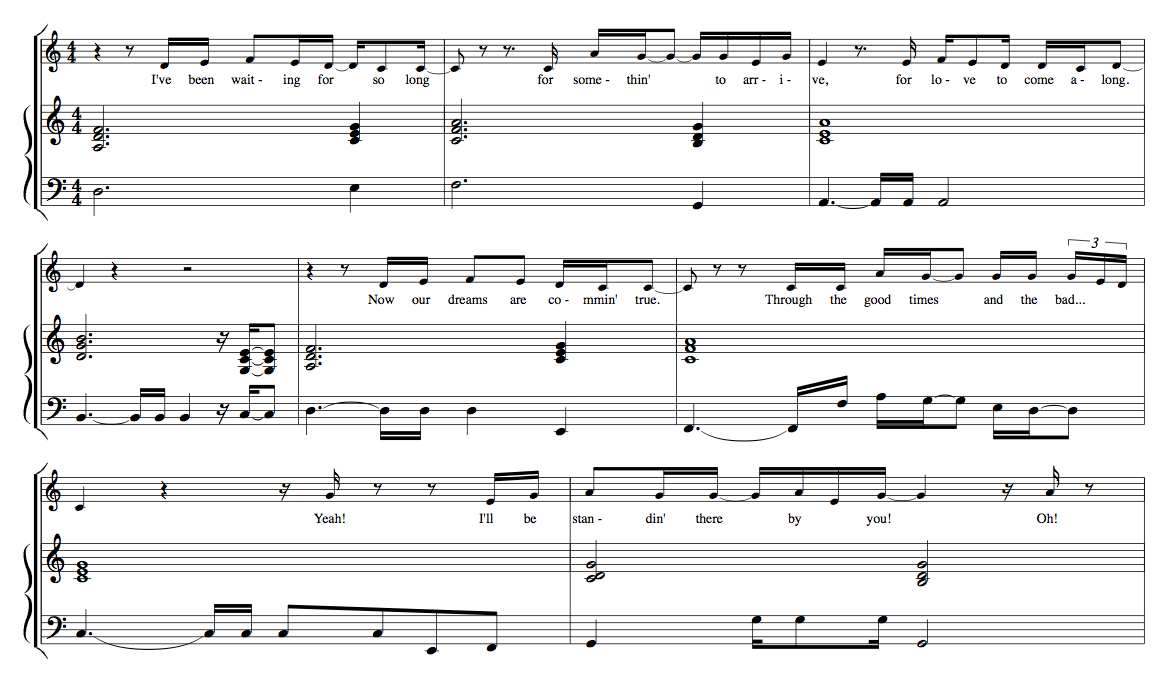Heaven
Bryan Adams (’84) & Talking Heads (‘79)


Boy howdy! Deciding which 2 of the roughly 700,000 songs titled “Heaven” to write about was a tough call (Los Lonely Boys & Aviici would make for an excellent round two). I decided to start with Bryan Adams and The Talking Heads because I was already familiar with the songs, and I ~loooves~ me a good Bryan Adams bridge. So let's get into it!
Bryan Adams’ “Heaven” proudly bears almost all the production and songwriting hallmarks of The Power Ballad¹ — a style which (save for a handful of semi-ironic re-imaginings) has basically vanished from the mainstream pop landscape entirely. It was the 3rd of 6 singles from the album Reckless (“Summer of ‘69” was #4).²
It was co-written by Jim Vallance and produced by legendary industry journeyman Jimmy Iovine. FunFact! Journey’s drummer Steve Smith filled in for this track when the Adams’ regular session drummer had to leave for a recording gig with Hall & Oates.
Thematically, this song is a straightforward declaration of love, and employs the lyrical trope of physicality being the superseding and dominant form of romantic communication. The slow, processional feel supports the verses’ conversational tone, and the grandiose chorus does not fail to satisfy.

We open on a slow-simmer intro, with a Rhodes and a CP-80-ish piano, with the tonic suspended on synth strings for effect. There’s a nice 2 beat pause at the end here, were you can easily imagine your future spouse dropping to one knee and pulling out the ring as you inhale an “oh my god” and start to tear up.
The verse is steady and relaxed, involving a pretty sweet turnaround in the 2nd half of the chord progression [C > Am > G > G > Dm > Am > Bb > Gsus > G] to emphasize how “young and wild and free” we were. Although short, this verse is lyrically well-constructed, eluding to indiscretions now promised to be a thing of the past. We get another pause at the end of the verse which serves as a nice breath before…
The hugest 80s drums ever and overdriven-but-tastefully-low-in-the-mix guitars explode onto the scene, letting us know we’ve hit the chorus. Adams resists returning to the tonic — instead starting on IV, which creates a nice feeling of inevitability to the climbing stepwise movement of the chord progression. The arrangement wisely keeps the instruments hitting on quarter notes, leaving plenty of space for the drum reverb, and allowing us to clearly absorb the vocals.
There’s some fun arrangement details in the 2nd verse, with the keys, guitar, and bass each stepping out for a second. The 2nd chorus is a a straight recap, with the guitars turned up slightly for emphasis (and the post-“We’re in heaven” guitar licks are juicier). An additional bar of vamping finally leads up to….
THAT. BRIDGE. Bryan Adams has THE BEST bridges. We get a bunch of sweet inversions [Dm > C/E > F > G > Am > G/B > C, Dm > C/E > F > C > Gsus > G]. We get a snare+tom on beat 4 of the 3rd measure to emphasize that indeed “love” has “come along”; and at the end of the first half, they do “that thing where everyone hits the 16th note after 4”. Once again, the bass steps out in the 2nd half, mirroring “the good times” vocal melody.

Next, there’s a quick (perfunctory-feeling) guitar solo over the chorus, followed by an epic triplet tom fill to get us into the final chorus. The lead guitar backs off for a moment to let Bryan come back swinging — singing the opening line to the last chorus as a descending melody… but quickly returns with some sweet licks poking through on the back half before he totally takes over for a glorious fade-out solo.
This song clocks in at a tidy 4:03. I feel like they easily could have doubled the length of the solo without causing fatigue… but like they say, it’s better to leave ’em wanting more.
alking Heads’ “Heaven” is a deep cut from 1979’s “Fear Of Music”. It’s the 2nd song on the comparatively mellower B side of the record, following the chirpy “Air”. This album was produced by everyone’s favorite art weirdo: Brian Eno.
While not a single, this song has had legs of its own; occasionally popping up in interesting media placements. As with many Talking Heads songs, its arrangement, production, and (perhaps most importantly) performative expression allows the material to transcend what is essentially “a simple chart with strange lyrics” to become something really special.
There’s a great live version of this song on the fantastic “Stop Making Sense” concert film, featuring off-stage vocal harmonies. FunFact!: There’s also a K.D. Lang version. 👌

Like I mentioned up top, this song doesn’t look like much on paper. We get an 8-bar intro, followed by 3 verses (split into 2 8-bar stanzas) alternating with 3 choruses (2 identical 8-bar stanzas). That’s it. Here’s a reduction of the entire song:


Note the key change from D major to G major in the chorus. This change, coupled with the chromatic descent in the 2nd measure gives the chorus a kind of spaghetti western vibe, further supported by the honky-tonk-ish piano (panned over to the left) which occasionally throws in chromatic licks.
The primary animating feature of the arrangement is the contrast between the steadyness of the rhythm section against the gradual swelling of the reverby lead guitars and increasing intensity of the vocals — an effect somewhat akin to watching billowing clouds passing over a desert mesa.
The drum part is amazing. Played almost exclusively on the kick, high hat, and snare with almost no variation in dynamics; the only drum fills occur in measures leading into and out of choruses, and minor high hat variations before chorus repetitions.
The bass part is likewise rock solid, dynamically static, and features the exact same (almost rhythmically identical) verse and chorus patterns throughout the entire song, without variation. The shorter notes on beats 1 and 3 are emphasized, creating a nice halftime feel against the backbeat.
During the verses, the mellow, twangy rhythm guitar plays an arpeggiated line which emphasizes beats 2& and 4, occasionally doing a pull-off trill on 4. The piano parts are just comping; they’re slightly different in each section.
Reverby lead lines float over almost the whole song, a riff on the “crying pedal steel” used in country tunes, but nudged further out into a lightly-flanged drone (I’m guessing this is an Eno decision).⁴
Against this backdrop, David Byrne’s unmistakable vocals take center stage. Initially delivered in a neutral, bored-seeming affect, each verse and chorus veer into increasing levels of perturbation. During the final chorus he steps out a bit, delivering some of his characteristic wails and yelps; Elvis-adjacent, landing somewhere between excitement and anxiety.
The lyrics to this song describe (in plainspoken language) a bar that “everyone is trying to get to” called “Heaven”, where “nothing ever happens”. As with many Talking Heads songs, these lyrics are best approached in a figurative context. The lyrical setting is also interesting: their melody and production appear to be in exact opposition to the substance of the text.

For example: in the 2nd half of this phrase, the statements “A place where nothing / nothing ever happens.” are set to dramatic intervalic leaps of a 6th followed by a full octave — by far the largest melodic movement in the entire vocal melody.
Again: this doesn’t look like much on paper, but in the context of Byrne’s uniquely overwrought delivery, coupled with the bubbling tape delays rolling off the vocals during the choruses, it transforms into an oddly romantic, dreamy affair.
These two songs are much closer in time and style than the other songs I’ve covered; but even so, they’re full of notable differences. For one, the difference in industry-standard drum production is clearly on display here; with the meaty, dry kits of the 70s giving way to wide-open toms, “trash can snares” and the most reverb humanly possible in the 80s.
Also of interest is the variation in what different producers can bring to a project. Iovine and the Adams camp are making production choices to build a strong narrative; using the arrangement and the song’s form (like the extra 2 beat pauses, and the bar of vamping before the bridge) to create a smooth “flow of understanding” for the listener. Eno, on the other hand, is using effects, and unusual production contrasts to create a space which mirrors the oddly non-committal “Heaven” portrayed lyrically.
[1] It’s missing a modulation entering or exiting the guitar solo, and falsetto wailing.
[2] I’m sure there’s a probably a take somewhere out there to the effect of “Adele’s Hello is a power ballad for the Millennials.”
[3] Note: The final A in the bass is replaced by an F# leading into the chorus.
[4] I couldn’t track down the specifics of what was used here, but I did come across this interview from a 1986 issue of “Music Technology Magazine”, wherein Jerry Harrison chats about the DX7 and Emu sampler... man, 1986 RULED!
[Side Note] In this interview, K.D. Lang describes being drawn to this song as a sort of Buddhist interpretation of Heaven.